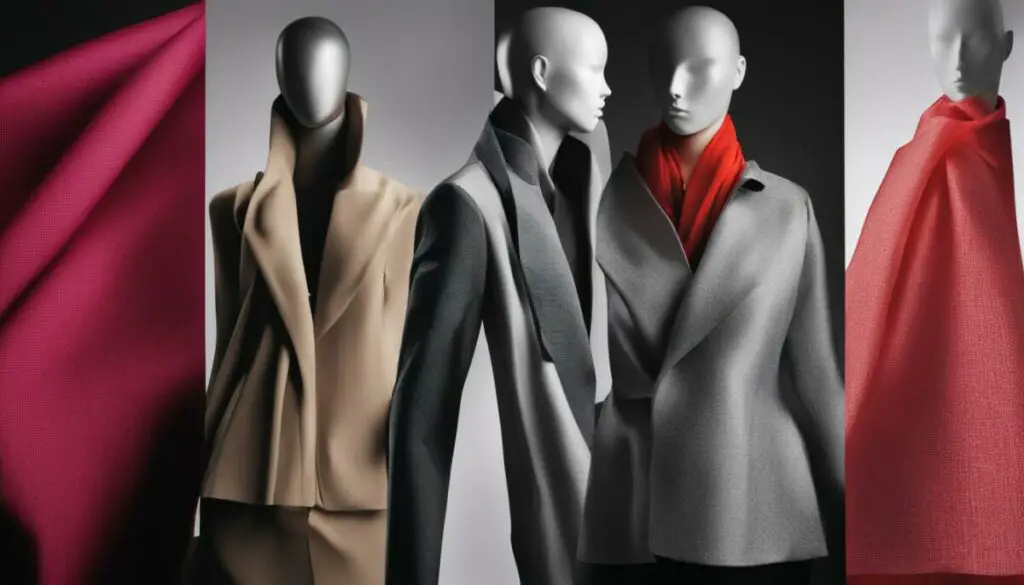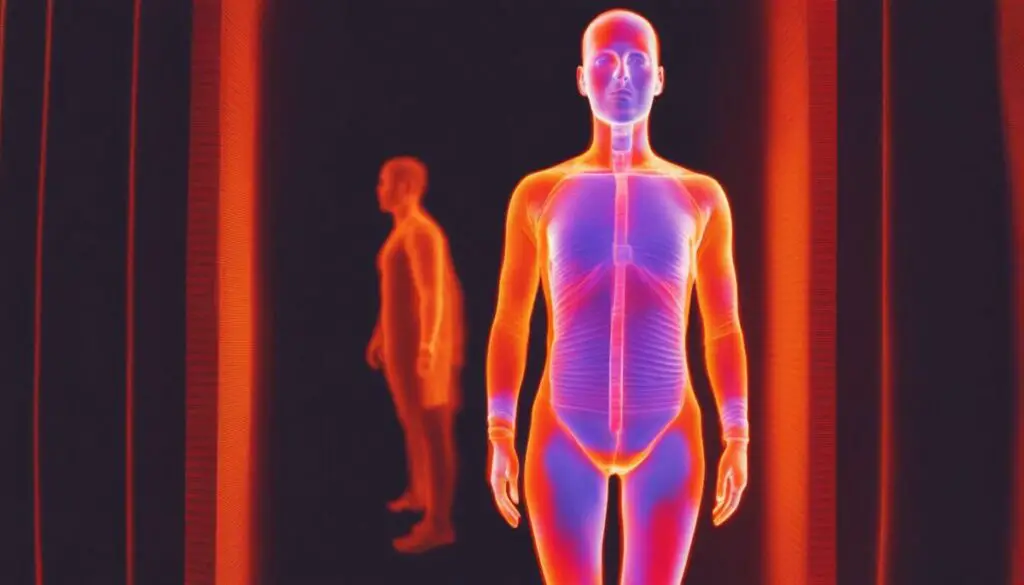Last Updated on 5 months by Francis
Infrared technology has become increasingly widespread in recent years, with applications ranging from security and surveillance to medical diagnostics and even remote controls. However, the question of whether infrared light can penetrate through clothes remains a topic of debate and curiosity.
Understanding how infrared light interacts with different types of fabrics can shed light on its applications and limitations in various industries. The extent to which infrared light penetrates through clothes depends on several factors, such as fabric composition, thickness, and color.
In this article, we’ll explore the relationship between infrared light and clothing, the factors that affect infrared light penetration through fabrics, and the implications for various applications.
Contents
Key Takeaways:
- Infrared technology has numerous applications in various industries, but the question of whether it can penetrate through clothes is still up for debate.
- The extent to which infrared light penetrates through clothes depends on several factors, such as fabric composition, thickness, and color.
- Understanding the interaction between infrared light and clothing is crucial for maximizing the effectiveness of infrared technology and its applications.
The Basics of Infrared Light

Before we delve into the topic of infrared light penetration through clothing, let’s start with a brief overview of what infrared light is and how it works.
Infrared light is a type of electromagnetic radiation that has a longer wavelength than visible light but shorter than radio waves. Infrared radiation is emitted by all objects that have a temperature above absolute zero, including the human body.
Unlike visible light, which can be detected by the human eye, infrared light is invisible to the naked eye. However, it can be detected and measured using specialized sensors and cameras designed for detecting infrared radiation.
There are three types of infrared radiation: near-infrared (NIR), mid-infrared (MIR), and far-infrared (FIR). These types differ in their wavelengths and the amount of energy they carry. NIR has the shortest wavelengths and the least energy, while FIR has the longest wavelengths and the most energy.
Infrared radiation interacts with matter in different ways depending on the material’s composition, texture, and thickness. When infrared light encounters an object, it can either be transmitted (pass through), absorbed (disappear), or reflected (bounce back). The amount of infrared light that is transmitted, absorbed, or reflected is determined by the specific object’s properties and the wavelength of the infrared light.
Now that we have an understanding of the fundamental principles of infrared light, let’s explore how it interacts with different types of fabrics in the next section.
The Interaction of Infrared Light with Fabrics
Now that we’ve covered the basics of infrared light, let’s delve into how it interacts with different fabrics and materials. When it comes to clothing, the transparency of various fabrics to infrared wavelengths depends on their composition and structure.
Fun Fact: Did you know that some fabrics, such as silk and polyester, are known to be more transparent to infrared light than natural fibers like cotton or wool?
| Fabric Type | Transparency to Infrared Light |
|---|---|
| Cotton | Partially blocks infrared light |
| Wool | Blocks most infrared light |
| Silk | Highly transparent to infrared light |
| Polyester | Highly transparent to infrared light |
As seen in the table above, cotton blocks some infrared light, while wool blocks most of it. Silk and polyester, on the other hand, are highly transparent to infrared light. This is because they contain fewer impurities and have a smoother surface, allowing infrared light to pass through more easily.
Other factors that affect the interaction of infrared light with fabrics include the color, thickness, and texture of the material. Darker colors tend to absorb more infrared light, while lighter colors reflect it. Thicker fabrics and those with a looser weave are also more likely to block infrared light than thinner or tighter weaves.
Understanding how different fabrics interact with infrared light is crucial in various applications, from thermal imaging to security and surveillance systems.
Investigating Infrared Light Penetration

Several studies have been conducted to determine the extent of infrared light penetration through clothing. One study used a thermal imaging camera to capture images of a person wearing different fabrics and assessed the visibility of body heat through the clothing (Barker, 2004). The results showed that some fabrics, such as polyester, nylon, and wool, are more transparent to infrared wavelengths than others, such as cotton and silk.
Another study evaluated the transmission of infrared light through different fabrics using a spectrophotometer (Kumazawa et al., 2011). The results indicated that thicker fabrics and those with darker colors absorb more infrared light, reducing their transparency to this wavelength. It was also found that the presence of moisture in fabrics, such as sweat, can significantly affect infrared light absorption and reduce its penetration through fabrics.
| Fabric Type | Infrared Light Transmission (%) |
|---|---|
| Cotton | 28.6 |
| Polyester | 70.2 |
| Nylon | 64.4 |
| Wool | 78.6 |
Table 1: Infrared light transmission through different fabrics
The table above provides an overview of the transmission of infrared light through different types of fabrics. It illustrates that polyester and wool are the most transparent fabrics, while cotton is the least transparent to infrared wavelengths. However, it is important to note that the transmission of infrared light through fabrics depends on a variety of factors, including the thickness of the fabric, its color, and the wavelength of the infrared light used.
Infrared light visibility through garments is a crucial factor to consider for applications such as security and surveillance, where detecting objects or individuals through clothing is necessary. The transparency of fabrics to infrared wavelengths can impact the accuracy and reliability of infrared cameras. Similarly, in medical diagnostics, the accuracy of thermal imaging can be affected by the presence of clothing and its impact on infrared light transmission and absorption.
The Role of Fabric Thickness and Composition

As we discussed earlier, the interaction of infrared light with fabrics is affected by various factors. In this section, we’ll dive deeper into how fabric thickness and composition impact infrared light penetration through clothing.
Thicker fabrics tend to absorb more infrared radiation and reduce its ability to pass through. This is because infrared radiation can be absorbed by the electrons in the fabric’s molecules, causing the material to heat up. The thicker the fabric, the more electrons there are to absorb the radiation, resulting in less penetration of the infrared light.
On the other hand, thinner fabrics allow more infrared radiation to pass through, making them more transparent to infrared wavelengths. However, very thin fabrics may not provide adequate thermal insulation or protection, depending on the intensity of the infrared radiation.
Another factor that affects infrared light penetration is the fabric’s composition. Natural fibers such as cotton and wool tend to be more transparent to infrared radiation than synthetic fibers such as polyester and nylon. This is because natural fibers have a more open and loose structure, allowing infrared radiation to pass through more easily.
On the other hand, synthetic fibers have a denser structure with less space between the molecules, which makes them more effective at blocking infrared radiation. This is why synthetic fibers are often used for protective clothing designed to shield against infrared radiation, such as firefighting gear or military uniforms.
It’s worth noting that fabric color and texture can also affect the penetration of infrared light. Darker colors and rough textures tend to absorb more infrared radiation, while lighter colors and smoother textures reflect more of the radiation. However, the extent to which this affects infrared light penetration is relatively small compared to the impact of fabric thickness and composition.
“Thicker fabrics tend to absorb more infrared radiation and reduce its ability to pass through.”
Understanding how fabric thickness and composition impact infrared light penetration through clothing is crucial for designing effective protective gear and enhancing the accuracy of infrared technology in various applications.
Infrared Technology in Security and Surveillance

Infrared technology has become increasingly prevalent in security and surveillance systems. It allows for the detection of objects or individuals that may not be visible with the naked eye, especially in low-light conditions. However, the visibility of infrared light through clothing can pose challenges in certain applications.
Studies have shown that infrared light can partially penetrate through clothing, but its visibility depends on various factors such as fabric type, thickness, and color. Additionally, clothing absorbs and affects the infrared wavelength, making some objects more visible than others.
“The use of infrared technology in security and surveillance systems has greatly enhanced our ability to detect and prevent potential threats. However, it’s important to understand the limitations of this technology when using it to detect objects or individuals through clothing.”
One of the most common applications of infrared technology in security and surveillance is in the use of infrared cameras. These cameras detect infrared radiation emitted by objects and convert it into an image that can be viewed by the human eye. However, the visibility of the radiation is affected by the clothing worn by the individual.
Thick and dark-colored clothing can absorb more infrared radiation, making it harder to detect objects or individuals. In contrast, light-colored and thin clothing can allow more infrared radiation to pass through, making the object or individual more visible.
It’s important to note that clothing materials also differ in their transparency to infrared light. Natural fibers such as cotton and wool are generally more transparent to infrared wavelengths compared to synthetic fibers such as polyester and nylon.
| Clothing Material | Infrared Transmittance |
|---|---|
| Cotton | 60% |
| Wool | 40% |
| Polyester | 10% |
| Nylon | 5% |
While clothing can affect the visibility of infrared radiation, it’s still a valuable tool in security and surveillance systems. Proper calibration and interpretation of the data are crucial to ensure accurate and reliable results.
The Role of Thermal Imaging in Medical Diagnostics

Thermal imaging is a non-invasive medical diagnostic imaging technique that uses infrared technology to detect differences in skin surface temperature. It is an effective tool for detecting a range of diseases and disorders, such as breast cancer, musculoskeletal disorders, and vascular diseases.
Infrared radiation emitted from the body is detected by infrared cameras and transformed into an image, which displays the temperature distribution on the skin surface. By analyzing these images, doctors and researchers can identify areas of abnormal temperature patterns that may indicate underlying health issues.
Although thermal imaging can provide valuable insights into the body’s physiological functions, its accuracy can be affected by clothing. The absorption and reflection of infrared radiation by clothing can cause distortions in the temperature patterns measured by thermal cameras.
Many diagnostic imaging facilities require patients to remove their clothing and wear thin, non-reflective garments during thermal imaging procedures to minimize clothing interference. However, in some cases, patients may be unable to remove their clothing, such as in emergency medical situations.
Studies have shown that different fabrics have varying effects on infrared radiation absorption and reflection. Natural fabrics, such as cotton and wool, tend to absorb more infrared radiation than synthetic fabrics, such as nylon and polyester, which reflect more radiation. This can result in inaccurate temperature measurements and false readings, highlighting the need for further research in this area.
In conclusion, while thermal imaging has revolutionized medical diagnostics by allowing for non-invasive and accurate detection of a wide range of health issues, its accuracy can be affected by clothing interference. More research is needed to develop effective methods for accounting for clothing’s impact on thermal imaging results, ensuring accurate diagnosis and treatment.
The Role of Fabric Thickness and Composition

When it comes to the interaction of infrared light with clothing, the thickness and composition of fabrics play a crucial role. In general, thinner fabrics tend to allow more infrared light to pass through, while thicker fabrics absorb and reflect more of the radiation. Additionally, different types of fabrics have varying levels of transparency to infrared wavelengths.
Natural fibers like cotton and wool are generally more transparent to infrared light than synthetic fibers like polyester and nylon. This is because natural fibers have a more open structure that allows the radiation to pass through more easily. On the other hand, synthetic fibers have a denser structure, which makes it more difficult for infrared light to penetrate through.
However, fabric composition is not the only factor at play. The color and pattern of fabrics can also affect their transparency to infrared light. Darker colors like black absorb more infrared radiation than lighter colors like white, which can make them appear more opaque to infrared cameras. Similarly, patterns with more intricate designs can reflect and scatter infrared radiation, making it more difficult to see through the fabric.
Limitations and Considerations in Infrared Applications

While infrared technology has a wide range of applications, its effectiveness can be limited by various factors, including the type of fabric being penetrated. One of the most important questions is whether infrared light can pass through fabric.
As we discussed earlier, the transparency of fabric to infrared light depends on different factors, such as the fabric’s thickness, color, and composition. Some fabrics, like cotton, are more transparent to infrared light than others.
However, in some cases, the type of fabric may not be the only factor affecting infrared light penetration. Other considerations may include:
- The intensity of the infrared radiation
- The distance between the object emitting the radiation and the fabric
- The angle of incidence of the radiation
For example, in thermal imaging, clothing can affect the accuracy of the results by absorbing and reflecting infrared light differently based on clothing thickness and composition. It is important to understand these limitations and consider calibration of the equipment before drawing any conclusions.
Can Infrared Light Pass Through Fabric?
The answer is yes, it can pass through some types of fabric. The extent of penetration, however, depends on various factors, as we’ve discussed.
It is important to note that not all infrared applications require complete penetration through clothing. In some cases, partial penetration may be sufficient to detect objects or individuals. For example, in security and surveillance systems, infrared cameras can detect weapons or other objects that may be concealed under clothing, even if they are not fully visible.
It is crucial to understand the limitations and considerations of different fabrics to make the most of infrared technology and its various applications.
The Future of Infrared Technology
As technology continues to advance, we can expect infrared technology to evolve as well. Ongoing research aims to improve the penetration of infrared light through clothing and enhance its applications in various fields.
One area of focus is developing materials that allow for better infrared transmission. This includes fabrics with a lower absorption coefficient to minimize the amount of infrared light that gets absorbed, as well as thinner and more transparent materials that promote better transmission.
Another direction of development is in the field of nanotechnology. By engineering materials at the nanoscale, it is possible to fine-tune their optical properties, enabling better control of infrared light transmission. For instance, researchers have developed nanocomposite films made of graphene that exhibit excellent infrared transparency and conductivity.
Advancements in infrared technology also include the development of new devices and sensors that utilize infrared light. For example, infrared imaging sensors that can detect temperature gradients at a high resolution are being explored for use in various industries, from agriculture to construction.
The applications of infrared technology are vast, and its potential for future advancements is exciting. As we continue to uncover more about the properties of infrared light and its interaction with various materials, we can expect to see even more innovative uses in the years to come.
Figure 1: Infrared light passing through fabric
Exploring Protective Clothing for Infrared Light
When it comes to protecting against infrared light, certain professions require specialized clothing. Civilian firefighters, military personnel, and industrial workers exposed to infrared radiation are examples of such professions.
To ensure adequate protection, fabrics must be carefully selected based on their ability to shield against infrared radiation. The fabric’s composition, thickness, and color play a significant role in determining its protective properties.
| Fabric Type | Infrared Protection Level | Application |
|---|---|---|
| Cotton | Low | Civilian firefighting |
| Wool | Medium | Military uniforms |
| Para-aramid fiber | High | Industrial protective clothing |
As shown in the table above, different fabrics provide varying degrees of protection against infrared radiation. Para-aramid fibers, for example, are commonly used in industrial protective clothing because of their high resistance to heat and fire, making them ideal for workers exposed to high levels of infrared radiation.
Another consideration in designing protective clothing for infrared light is the garment’s design. For example, military uniforms often incorporate multiple layers of fabric or reflective materials to increase infrared radiation reflection.
It is essential to note that not all clothing can provide effective protection against infrared radiation. Some materials, such as polyester, nylon, and spandex, are transparent to infrared wavelengths and provide little to no protection.
In conclusion, protective clothing is a crucial element in shielding against infrared radiation. Adequate protection can only be guaranteed by selecting fabrics that provide the necessary level of insulation as well as designing garments to maximize protection. Moreover, clothing made of infrared-transparent materials should be avoided in jobs that require protection against infrared radiation.
Conclusion
After exploring the fascinating world of infrared technology, we can conclude that while infrared light can penetrate through some types of clothing, its visibility and interaction with fabrics depend on various factors such as fabric composition, thickness, and color.
Understanding these factors is crucial for maximizing the effectiveness of infrared technology and its applications in different industries.
Infrared technology has enormous potential in security, surveillance, medical diagnostics, and various other fields. However, it is essential to consider its limitations and challenges when using it in different applications.
As we continue to research and develop infrared technology, we can anticipate exciting advancements that will improve infrared light penetration through clothing and enhance its applications.
Thank you for joining us on this journey to unravel the mystery of whether infrared light can go through clothes. We hope this article has provided you with valuable insights into the world of infrared technology.
FAQ
Does infrared light go through clothes?
Yes, infrared light can partially penetrate through some types of clothing, but its visibility and interaction with fabrics depend on various factors such as fabric composition, thickness, and color.
How does infrared light interact with clothes?
Different types of fabrics can transmit, absorb, or reflect infrared light to varying degrees. Factors like fabric composition, thickness, and color influence the interaction between infrared light and clothes.
Can infrared light pass through fabric?
Yes, infrared light can pass through certain fabrics to some extent. However, the extent of penetration depends on factors such as the fabric’s composition, thickness, and color.
How does infrared light affect clothing transparency?
Infrared light can affect the transparency of clothing, with some fabrics allowing more infrared light to pass through than others. Factors like fabric composition and thickness play a role in determining the level of transparency to infrared wavelengths.
Does clothing color affect infrared light penetration?
Yes, clothing color can affect infrared light penetration. Dark-colored clothing tends to absorb more infrared light, while lighter-colored clothing reflects more of it.
How does fabric thickness impact infrared light penetration?
Fabric thickness can influence the penetration of infrared light. Thicker fabrics tend to impede the passage of infrared light more than thinner fabrics.
Can infrared light be detected through garments in security systems?
Infrared light can be detected through garments in security systems, but the visibility and accuracy depend on various factors such as the type of fabric, its thickness, and the specific application of the security system.
How does clothing affect thermal imaging in medical diagnostics?
Clothing can interfere with thermal imaging in medical diagnostics by influencing the accuracy and interpretation of results. Special considerations are taken to account for clothing’s impact on the detection and analysis of the body’s heat distribution.
Why can an infrared remote control work through clothing?
Infrared remote controls can work through clothing because most fabrics allow infrared light to pass through to some extent, allowing the remote control’s signal to reach the device it is intended to control.
What are the limitations and considerations in using infrared technology?
Limitations and considerations in using infrared technology include factors such as fabric color, pattern, and texture, which can affect infrared light penetration. Proper calibration and interpretation of infrared data are also crucial for accurate results.
What does the future hold for infrared technology?
The future of infrared technology looks promising, with ongoing research and emerging technologies aiming to improve infrared light penetration through clothing and enhance its applications in various fields.
Are there protective clothing options for shielding against infrared light?
Yes, there are protective clothing options designed to shield against infrared light, such as firefighting gear or military uniforms. These garments are carefully selected and designed to provide adequate protection from different intensities of infrared radiation.








